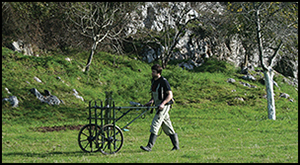Crossref Citations
This article has been cited by the following publications. This list is generated based on data provided by
Crossref.
Rigaud, S.
and
Gutiérrez-Zugasti, I.
2016.
Symbolism among the last hunter–fisher–gatherers in northern Iberia: Personal ornaments from El Mazo and El Toral III Mesolithic shell midden sites.
Quaternary International,
Vol. 407,
Issue. ,
p.
131.
Cubas, Miriam
Altuna, Jesús
Álvarez-Fernández, Esteban
Armendariz, Angel
Fano, Miguel Ángel
López-Dóriga, Inés L.
Mariezkurrena, Koro
Tapia, Jesús
Teira, Luis C.
and
Arias, Pablo
2016.
Re-evaluating the Neolithic: The Impact and the Consolidation of Farming Practices in the Cantabrian Region (Northern Spain).
Journal of World Prehistory,
Vol. 29,
Issue. 1,
p.
79.
2017.
Shells and Humans: Molluscs and Other Coastal Resources from the Earliest Human Occupations at the Mesolithic Shell Midden of El Mazo (Asturias, Northern Spain).
Papers from the Institute of Archaeology,
Vol. 27,
Issue. 1,
Arias, Pablo
Diniz, Mariana
Cubas, Miriam
Duarte, Carlos
Iriarte, Eneko
Salzmann, Christoph
Teichner, Felix
and
Teira, Luis
2017.
Looking for the traces of the last hunter–gatherers: Geophysical survey in the Mesolithic shell middens of the Sado valley (southern Portugal).
Quaternary International,
Vol. 435,
Issue. ,
p.
61.
Alday, Alfonso
Domingo, Rafael
Sebastián, María
Soto, Adriana
Aranbarri, Josu
González-Sampériz, Penélope
Sampietro-Vattuone, María Marta
Utrilla, Pilar
Montes, Lourdes
and
Peña-Monné, José Luis
2018.
The silence of the layers: Archaeological site visibility in the Pleistocene-Holocene transition at the Ebro Basin.
Quaternary Science Reviews,
Vol. 184,
Issue. ,
p.
85.
García-Escárzaga, Asier
Gutiérrez-Zugasti, Igor
Cobo, Adolfo
Cuenca-Solana, David
Martín-Chivelet, Javier
Roberts, Patrick
and
González-Morales, Manuel R.
2019.
Stable oxygen isotope analysis of Phorcus lineatus (da Costa, 1778) as a proxy for foraging seasonality during the Mesolithic in northern Iberia.
Archaeological and Anthropological Sciences,
Vol. 11,
Issue. 10,
p.
5631.
Lillios, Katina T.
2019.
The Archaeology of the Iberian Peninsula.
Fano, Miguel Ángel
2019.
The Mesolithic “Asturian” culture (North Iberia), one century on.
Quaternary International,
Vol. 515,
Issue. ,
p.
159.
Milano, Stefania
Schöne, Bernd R.
González-Morales, Manuel R.
and
Gutiérrez-Zugasti, Igor
2022.
Temporal and spatial variability of prehistoric aquatic resource procurement: a case study from Mesolithic Northern Iberia.
Scientific Reports,
Vol. 12,
Issue. 1,
García-Escárzaga, Asier
Gutiérrez-Zugasti, Igor
Cuenca-Solana, David
González-Morales, Manuel R.
Hamann, Christian
Roberts, Patrick
and
Fernandes, Ricardo
2022.
Bayesian estimates of marine radiocarbon reservoir effect in northern Iberia during the Early and Middle Holocene.
Quaternary Geochronology,
Vol. 67,
Issue. ,
p.
101232.





